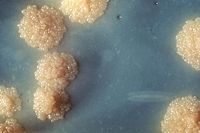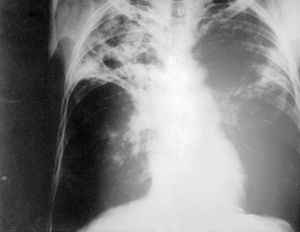Mycobacterium tuberculosis: Difference between revisions
imported>Alex Lee |
imported>Alex Lee |
||
| Line 117: | Line 117: | ||
- Interference with oxygen intermediates | - Interference with oxygen intermediates | ||
==Current Research== | ==Current Research== | ||
Revision as of 17:34, 18 April 2008
Articles that lack this notice, including many Eduzendium ones, welcome your collaboration! |
 | ||||||||||||||
| Scientific classification | ||||||||||||||
| ||||||||||||||
| Binomial name | ||||||||||||||
| Mycobacterium tuberculosis |
Description and significance
Mycobacterium tuberculosis was first isolated and described in 1882 by Dr. Robert Koch, who later went on to win the Nobel Prize in 1905 for his discovery. Also known as, "Tubercle Bacillus", and Koch's bacillus, M. Tuberculosis is a non-motile, rod shaped bacterium, and the primary cause for the widespread disease tuberculosis.
The World Health Organization estimates that one-third of the world's population is infected with M. Tuberculosis, and that someone new is infected every second. [1] With the emergence of drug resistant strains, both multi drug resistant (MDR) and extensively drug resistant (XDR), controlling the spread of tuberculosis has become a major concern. Since 2006, the WHO's primary strategy in its Stop TB Strategy has been the use of DOTS (Directly Observed Treatment, Short-course). It is estimated to be the most cost effective strategy, only costing $3-$7 to gain a year of health. [2]
Genome structure
The genome for two strains of M. Tuberculosis have been sequenced completely. In 1998, the Sanger Institute sequenced the common laboratory strain, H37rv. At the same time, strain CD1551 was sequenced by The Institute for Genomic Research (TIGR) using the whole genome random sequencing method (shotgun sequencing). The CDC-1551 strain has been shown to be more virulent than the H37rv strain. By comparing both genomes, key information can be obtained about the virulence, survivability (drug resistance), and evolution of M. Tuberculosis. [3][4]
Chart from "TIGR"summarizing the CDC-1551 strain
| DNA Molecule Summary | ||
| Total Number of all DNA molecules: | 1 | 100.00% |
| Total Size of all DNA molecules: | 4403837 bp | 100.00% |
| Number of Primary Annotation coding bases: | 4069477 bp | 92.40% |
| Number of G+C bases: | 2889216 bp | 65.60% |
| Primary Annotation Summary | ||
| Total genes: | 4294 | 100.00% |
| Protein coding genes: | 4246 | 98.88% |
| Genes assigned a role category: | 2317 | 54.56% |
| Genes not assigned a role category: | 2 | 0.04% |
| Conserved hypothetical genes: | 655 | 15.42% |
| Hypothetical genes: | 1272 | 29.95% |
| tRNA genes: | 45 | 1.04% |
| rRNA genes: | 3 | 0.06% |
Cell structure and metabolism
M. Tuberculosis is a non-motile, rod shaped bacterium roughly 2-4 um in length and 0.2-0.5 um in width. It's an obligate aerobe and neither gram positive or negative. Although it has a peptidoglycan layer, M. Tuberculosis does not retain the crystal violet dye. To solve this issue, acid-fast staining is used (specifically Ziehl-Neelsan Stain). The peptidoglycan layer is of particular interest. It is composed mostly of lipids (60%). The high lipid percentage (lipids: Mycolic Acid, Cord Factor, Wax-D) is the likely cause of the high survivability of M. Tuberculosis. Factors include: impermeability to stains; resistance to antibiotics, osmotic lysis, acidic and alkaline compounds, and protection from oxygen free radicals. other factors that add to the survivability of M. Tuberculosis include the ability to grow intracellularly within macrophages (exact reason is unknown), and it's slow rate of growth compared to other bacteria (about 15-20 hours). The slow rate of growth may deter it's detection by the immune system.[5]
Ecology
M. Tuberculosis generally resides in the lungs where oxygen is more readily available. However, if the bacteria enters the blood stream, or lymphatic system, it can spread throughout the body and infect various other organs (brain, kidney, liver, etc.) When this happens, it is known as miliary tuberculosis.
M. Tuberculosis has an increased capability to survive outside our system due to its highly lipid based peptidoglycan layer. Within our system, M. Tuberculosis are consumed by macrophages, however lysosome-phagosome fusion is prevented, and M. TB is able to grow inside the macrophages.[6][7]
Pathology
(Temporary General Outline)
- Major cause of tuberculosis (can link to tuberculosis page later)
- Binding to mannose receptors (for entry into cell)
- Ability to prevent lysosome from fusing with phagosome, as a result prevents the destruction of the bacteria.
- Slow generation may actually help the bacteria from being detected by the immune system.
- Cell wall construction is 60% lipid. Lot of different types of resistances.
- Antigen 85: binds to fibronectin and may help in protecting the bacteria from the immune system.
- Interference with oxygen intermediates
Current Research
Summaries to come
Pubmed article about BCG vaccine
Pubmed article about the discovery of lipolytic enzymes which may be involved with virulence
Article concering multi-drug resistant mycobacterium tuberculosis
References
- ↑ http://www.who.int/mediacentre/factsheets/fs104/en/index.html
- ↑ http://www.tbalert.org/worldwide/DOTS.php
- ↑ http://cmr.tigr.org/CMR/org_gmt.shtml
- ↑ http://www.biohealthbase.org/GSearch/aboutMycobacterium.do?decorator=Mycobacterium
- ↑ http://www.textbookofbacteriology.net/tuberculosis.html
- ↑ http://www.biohealthbase.org/GSearch/aboutMycobacterium.do?decorator=Mycobacterium
- ↑ http://www.textbookofbacteriology.net/tuberculosis.html

